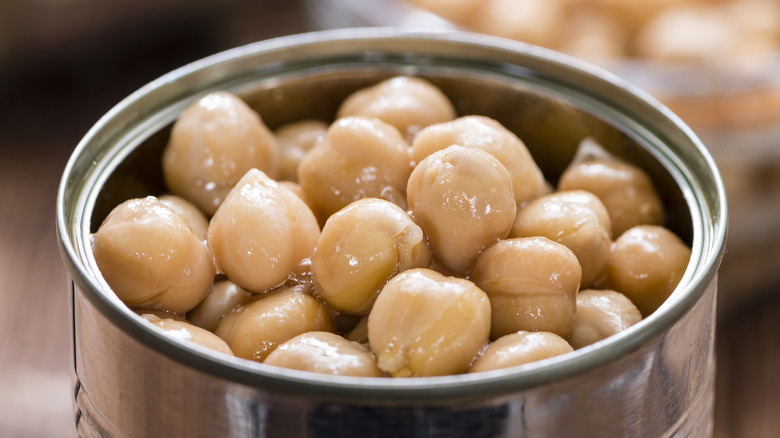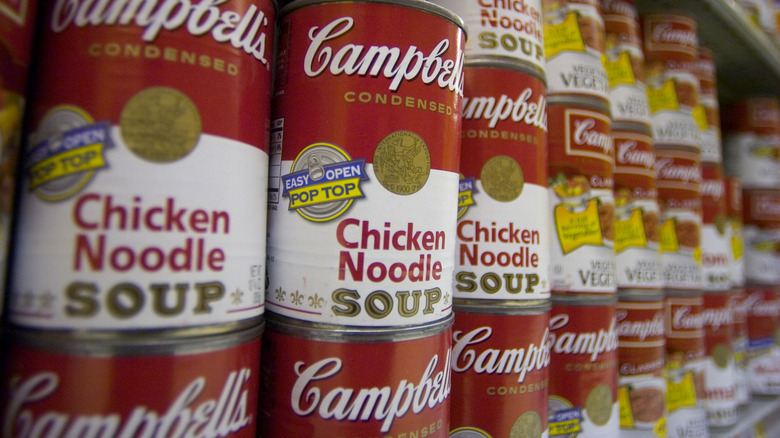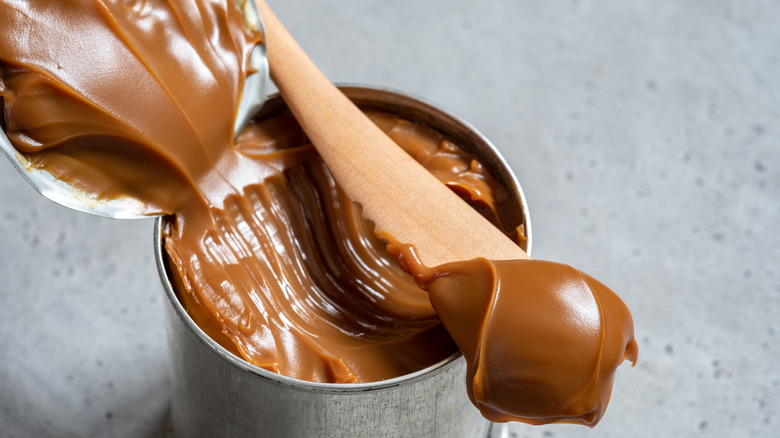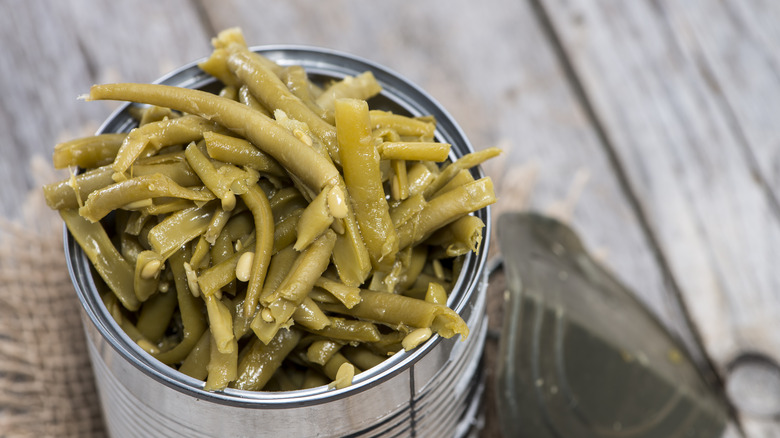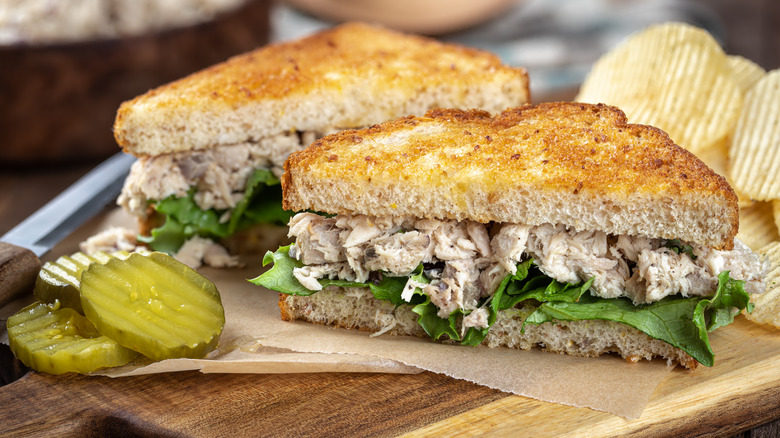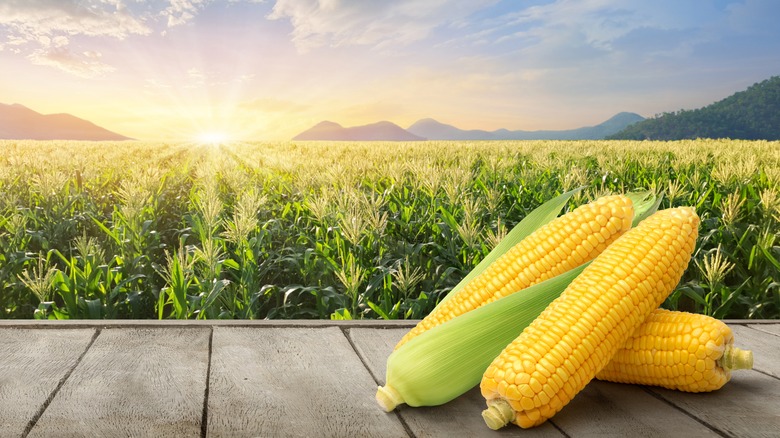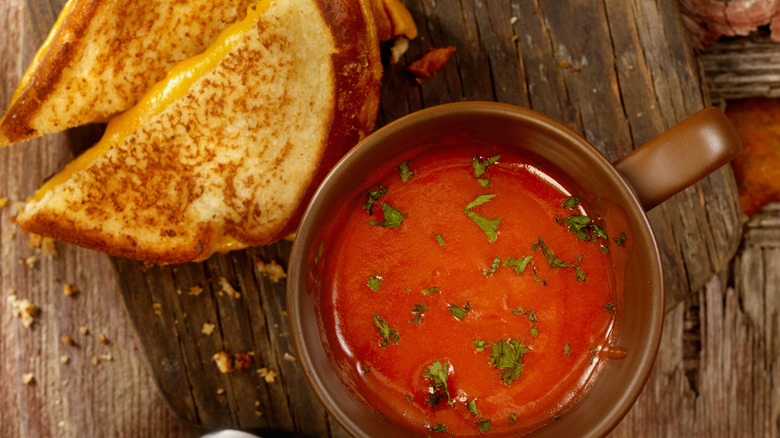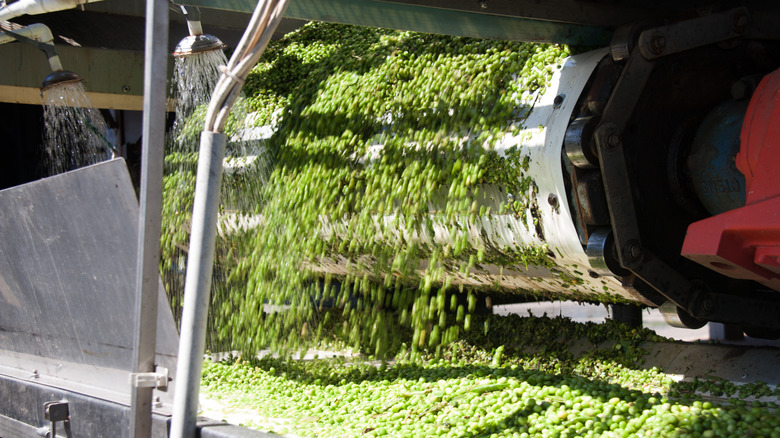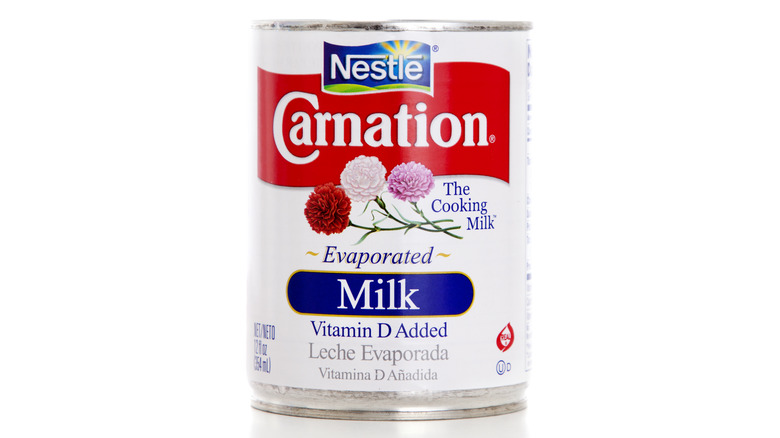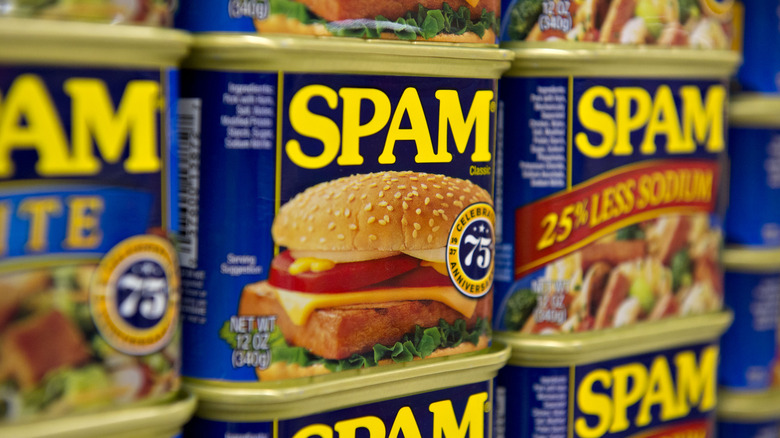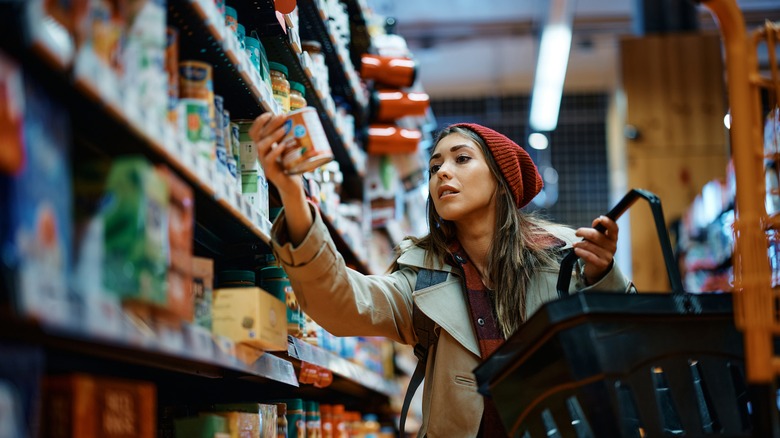Chef Reveals The Canned Foods They Will And Won't Buy
Cans of food offer convenience, a long shelf life, and access to food in all seasons. And, well, you know, sustenance for all those end-of-world scenarios! But here's the thing: Even if the world isn't ending anytime soon — and we certainly hope that it doesn't — cans of food might make us a little concerned. For one thing, are we trading off nutrition? Messing with taste? Hurting the planet with their environmental impact? Where the love for pure, quality ingredients meets our need for quick and easy meals, the topic of canned food comes to the forefront.
We checked in with chef Harris Mayer, owner and chef of Creamline in New York City, for his perspective on using canned food. Known for comforting American classics, Creamline prides itself on working with local farmers and using only the highest-quality ingredients. So if Mayer gives the nod to a canned product, you know it's for good reason. And if you've never been to Creamline, just one peek at the mouthwatering shots on their Instagram will have you convinced it's run by the wizards of the food world. We got the scoop from Mayer on his go-to canned items and the ones he steers clear of. Stick around until the end of the article for more about the methodology behind the following "buy" and "avoid" list.
Buy: canned chickpeas (aka garbanzo beans)
Canned chickpeas (aka garbanzo beans), are among Harris Mayer's favorite canned foods. As he explains, "They are consistent and perfectly cooked, as long as you thoroughly rinse the starchy water off of them and refresh in ice cold water, they are great for certain applications." Though he hesitates to say it out loud, Mayer admits that "high-quality canned chickpeas are great for hummus." With a can of chickpeas, a basic hummus recipe takes just 20 minutes. But why stop there? Beyond the realms of hummus, toss chickpeas into soups or salads for a nutritious boost, let them stand in as a meat-free protein in your pasta dishes, or smash them into a spread to revolutionize your sandwich game.
Smashed or otherwise, it's worth finding ways to incorporate chickpeas into your diet. Even canned, chickpeas offer numerous health benefits. A 2020 study in Plant Foods for Human Nutrition reveals chickpeas are not just full of protein — they're also loaded with antioxidants and anticancer properties.
To get every drop of benefit from a can of chickpeas, when you drain the chickpeas, don't toss out the liquid! Chickpea water can be used as an egg substitute and works especially well to replace egg whites in airy food. Known as aquafaba ("bean water"), the liquid that usually goes down the drain can instead be whipped up into meringue, mousse, or whipped cream.
Avoid: canned soup
As chef and owner of New York City's Creamline, Harris Mayer knows something about soup. The restaurant's House-Made Jersey Crushed Tomato Soup isn't just any soup — it's the soulmate to their iconic grilled cheese. As for canned soup? Mayer's not interested. He says, "It is crazy salty, wreaks of overcooked celery, and it always tastes fake." Not exactly a warm, comforting meal.
Canned soup's disappointing flavor isn't just bad for your taste buds — it's also bad for your health. Sodium's not-so-secret affair with canned soup is linked to a roll call of health no-nos. A 2020 study in the International Journal of Molecular Sciences notes, "Excessive sodium intake is associated with the development of a variety of comorbidities including hypertension, chronic kidney disease, stroke, and cardiovascular diseases."
Even knowing the health risks, a chilly evening makes it hard to turn down a quick and easy warm meal. But instead of keeping canned soup on hand, simmer up a big pot of soup and freeze it in single-serve portions. Your future self will appreciate this tastier and healthier version of convenience. Unfortunately, you will want to avoid freezing dairy-based soups. Creamy soups are a bit like divas — they don't like the freezer and might throw a grainy texture tantrum when reheated. But a hearty and simple chicken noodle soup? That's a performer that freezes beautifully and reheats to warm the soul.
Buy: sweetened condensed milk
Gail Borden struck liquid gold when he invented canned sweetened condensed milk. He sold the cans to the military during the Civil War, providing Union troops with nourishing and tasty milk that wouldn't go bad in their packs. A world where milk didn't spoil was revolutionary, quickly turning this military staple into a pantry staple. Creative chefs around the globe found good uses for sweetened condensed milk, especially for dessert favorites like flan, key lime pie, and tres leches cake.
Chef Harris Mayer counts sweetened condensed milk as one of his favorite canned foods because it's his ticket to dulce de leche. For such a decadent treat, boiling homemade dulce de leche is a rather simple process — remove the can's label and keep the sealed can fully submerged in boiling water for a few hours. But heed Harris Mayer's tale of woe: "Be sure you keep the water level high throughout the process," he explains. "I had a caramel explosion once that was a nightmare to clean up, my entire apartment looked like spin art!"
If you're not keen on the risk of a messy explosion, there are many other ways to use sweetened condensed milk. A splash of this creamy dream can do wonders for a sweeter cup of joe. You've also found a secret ingredient for enhancing cornbread mix. Or perhaps venture into the savory with caramelized pork that will have your guests tipping their hats to Borden, the unsung hero of your kitchen.
Avoid: canned cooked green vegetables
Harris Mayer officially puts canned green vegetables on his "Do Not Buy" list. His reasoning is simple: "The texture is always too mushy." And given everything those veggies go through in the canning process, it's no wonder they wind up mushy.
Before they're even canned, vegetables such as green beans get a quick spa treatment called blanching. They take a brief dive in boiling water to stop enzyme actions, which sounds nice until you realize it wreaks havoc on their flavor, color, and texture. Their journey to mushville continues as the canning process cranks up the heat to blast away any bacteria, ensuring the veggies won't spoil. But, for our green vegetable pals, this means their cellular structure takes a hit, transforming them from crisp and crunchy to soft and mushy.
Despite the mushiness, canned vegetables still pack a nutritional punch — they can be part of a convenient and accessible healthy diet. However, the blanching process may diminish antioxidant activity in those canned veggies. A 2002 study in Innovative Food Science & Emerging Technologies took a peek at canned versus frozen spinach and found that frozen spinach had substantially higher antioxidant activity. As the cans are losing out on antioxidant activity, many cans are gaining sodium with added salt. So, while canned greens might win the convenience trophy, they might not be taking home the gold when it comes to taste or health.
Buy: canned tuna
Canned tuna actually excites Harris Mayer. "Not even high-end Mediterranean stuff," he says, "but good old American canned tuna makes great tuna salad, one of my favorite things!" Mayer is not alone in this — even Julia Child, the queen of cuisine herself, enjoyed a tuna salad sandwich with Hellmann's mayonnaise as one of her favorite lunches. But it doesn't have to be Hellmann's mayo — or any mayo, for that matter. Versatility is one of canned tuna's great strengths. For a change of pace, consider substituting the mayo in your tuna salad. Greek yogurt adds a tangy twist, Dijon mustard adds a spicy kick, and the list goes on — how about hummus, ranch dressing, or pesto? The world is your oyster ... or should we say, your tuna can?
Nutrition-wise, canned tuna is like the superhero of the pantry, packed with protein, vitamins, minerals, and those heart-loving omega-3 fatty acids. But, like all heroes, it has its kryptonite — or, you know, mercury. The good news? According to WebMD, canned tuna typically has less mercury than its fresh counterpart, thanks to the smaller fish that make the can cut. That said, it's always a good idea for expecting moms and little ones to have a chat with their doctor before diving into the tuna stash.
Avoid: canned corn
Corn is a staple in many parts of the world. But when it comes to canned corn, Harris Mayer doesn't hold back his feelings: "It simply tastes bad and loses its juicy texture, and I find canned corn to be very waxy." Indeed, nothing quite beats the sweet crunch of fresh corn when it's available. But, alas, fresh corn plays hard to get outside its season.
In the absence of fresh corn, frozen corn is the hero and canned corn is barely a sidekick. Freezing is one of the oldest and most widely used techniques for food preservation. This age-old method locks in that peak-season goodness and ensures that corn kernels remain as plump and nutritious as the day they were picked. Thanks to the magic of flash freezing, corn can be picked, husked, bagged, and frozen so fast that it goes from farm to freezer within 10 hours.
And for those desperate times when canned corn is your only companion, do not despair! Transform its mushy demeanor and sad, tinny aftertaste by blitzing it into oblivion within the cozy confines of a chowder. Consider Cajun-style corn chowder as an example, where the canned corn's mediocrity is buried with a blend of spices — not to mention bacon and sausage, which make canned corn a lot more tolerable. Everything tastes better with bacon, right?
Buy: canned tomatoes for sauce and soup
Imagine crafting the perfect tomato soup to cozy up alongside a gooey grilled cheese sandwich. Chef Harris Mayer, the culinary wizard behind New York City's Creamline, has cracked the code: "At Creamline, we use crushed Jersey tomatoes and San Marzano style tomatoes from California to make our tomato soup ..." And then comes the surprising detail: "In 1,000 years, I wouldn't use fresh tomatoes for this."
Wait, but fresh is always best, right? Not quite, especially when those tomatoes have to trek all the way from sunny California to bustling New York City. "Anytime produce is shipped," Mayer says, "it is usually picked underripe and gets preservative coatings, which we don't want in our Creamline tomato soup." The road traveled for a sensitive tomato is a rough one. Every jostle and shake in the truck bed damages the tomato — a 2021 study in Horticulturae documents that these vibrations impact ripening levels and firmness. The poor tomato loses water and is vulnerable to shriveling and bruising. After this cross-country adventure, the tomato arrives as only a shadow of its former, juicy self.
This is where the can plays savior. Mayer explains, "Canned tomatoes are done near the farms, they get them to peak ripeness in peak season and then can them." This means canned tomatoes offer all the flavor and quality we crave, without any of the travel woes.
Avoid: canned peas
Peas were one of the first vegetables to be preserved by canning, but just because it's an oldie, doesn't mean it's a goodie. Chef Harris Mayer gives canned peas a firm thumbs down, calling them "lifeless and gray." If you've ever cracked open a can of peas, you might find yourself nodding in agreement. Canned peas? More like canned disappointments. The off-color contents within that can have been through the ringer. The canning process does no favor to their texture or taste. Thermal processing leads to increased mushiness. Heat treatment transforms peas from their vibrant green to something that looks and tastes dull.
Fresh peas are delicious but often impractical with their limited seasonal appearances, labor-intensive shelling process, and short shelf life once harvested. But that doesn't mean we have to swear off peas altogether! With cans ruled out, Mayer recommends frozen as a better option. Frozen peas are caught at their prime, flash-frozen to capture their sweet essence, bright hue, and all the nutritional value nature packed into them. Some might even say they outshine the so-called "fresh" peas at the store, which have probably seen more of the world than you have by the time they land in your shopping cart. With near-fresh quality, frozen peas are ready to leap into action in any dish, from adding a pop of color to your salads to cozying up in a warm soup.
Buy: evaporated milk
Evaporated milk is the unsweetened cousin of sweetened condensed milk. Both these shelf-stable milks have kicked about 60% of their water weight to the curb. As the chef and owner of Creamline, Harris Mayer counts evaporated milk as one of his favorite canned foods. "We use it for our house-made cheese sauce at Creameline," he says. "It adds stability to the emulsion when we melt in the shredded cheddar."
Creamline's cheese sauce is reason enough to appreciate the magic of evaporated milk. But the magic of evaporated milk doesn't stop at cheese sauce glory. Since the evaporation process removes water from the milk, evaporated milk offers concentrated dairy goodness, providing a depth of flavor that fresh milk cannot. It's a lower-fat, flavor-packed alternative to heavy cream that your soups, casseroles, and creamy sauces have been dreaming of. And because it's not afraid of a little heat, it won't curdle at the first sign of a hot stove.
Evaporated milk's impressive shelf life means you can always have a backup if you suddenly realize you're out of fresh milk. To substitute fresh milk, dilute evaporated milk with an equal amount of water. This means if your recipe calls for 1 cup of milk, you would mix 1/2 cup of evaporated milk with 1/2 cup of water to make a cup of milk substitute. And just like that, evaporated milk is a pantry essential that's always ready to save your culinary day.
Other canned foods to consider
Harris Mayer is a busy chef and can't speak to all the abundant canned options out there, so here's a candid take on a couple other canned options. First up, let's talk about canned pumpkin. The culinary world gives it a big thumbs-up. Both Ina Garten, the food writer and host of Food Network's "Barefoot Contessa," and chef Tim Hollingsworth, the winner of Netflix's "The Final Table," embrace canned pumpkin. Imagine the hassle of wrestling with a real pumpkin — gutting, cooking, pureeing — sounds like a Halloween horror story! Thankfully, canned pumpkin makes life easier and cleaner when preparing fall treats and holiday desserts. But it's not just for bread and pies anymore! Chef Giada De Laurentiis uses canned pumpkin for an amazing carbonara. Yes, you read that right — pumpkin in carbonara. Who knew?
And then there's SPAM. No chat about canned goods would be complete without tipping our hats to the iconic SPAM. Chef Chris Oh, known for his culinary creativity, advocates for SPAM. He loves SPAM's versatility, telling Mashed, "You can deep fry it. You can pan fry it. You can steam it. You can boil it. You can put it into soups. You can put it into sandwiches. You can put it in tacos ... And it's very easy to cook, too." That ease of use is partly why SPAM, along with so many other food cans, helps keep the kitchen filled with a can-do attitude.
Static Media owns and operates Food Republic and Mashed.
Methodology
The "buy" and "avoid" list in this article draws from Food Republic's exclusive interview with chef Harris Mayer, chef and owner of Creamline in New York City. Mayer was asked about his favorite canned foods and why they're his favorites. In his reply, he shared that chickpeas, condensed and evaporated milk, tuna, and tomatoes are great in a can. He was also asked what canned foods he'd never buy and why. He said that he would never buy canned soup, cooked green vegetables, corn, or peas. He was also asked about his favorite canned food that will enhance another dish. His response was evaporated milk.
The section on "Other canned foods to consider" was written without input from Mayer. That section relied on research to find top chefs who agreed on a canned product they would use in their kitchen.


